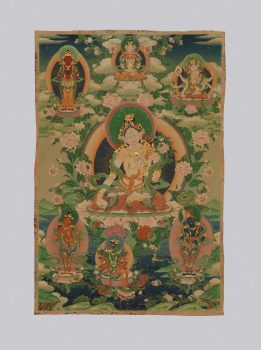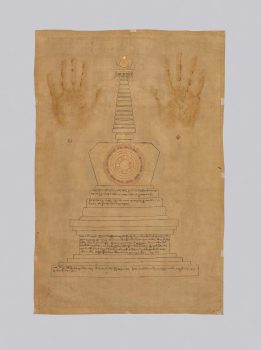Tibet
19th century
The right hand is extended in a giving gesture.
Tibet
19th century


As a female buddha, Tara works for the benefit of all beings and has many manifestations. This form, known as White Tara, bestows longevity. Her right hand rests on her knee, displaying the gesture of infinite generosity, while the left holds the stem of a pure white lotus blossoming above her shoulder. The reverse of the painting is particularly interesting; it contains a depiction of a stupa with a mandala drawn in its dome and handprints of a Buddhist master. Prayers and dedications written in gold on the stupa’s body state that this painting was commissioned by Yeshe Lopsang Tenpa, likely the Eighth Tatsak Rinpoche (1760–1810). Taking refuge in Tara, he dedicates the merit of the painting’s creation to preventing untimely death and other dangers for all sentient beings and asks to bestow the blessings of a long and auspicious life. The handprints and the small seal prints underneath them may be his own.
A kind of energy that can be used, individually and collectively, to effect change.
While the primary religious goal for followers of Buddhism is enlightenment, many of the practices also serve secular goals related to daily life, including ethical conduct and cultivating well-being.
Prescribed practices that carry symbolic meaning and value within a specific tradition and are intended to attain a desired outcome. Rituals are usually done as part of a ceremony or regular routine.
Female bodhisattvas and tantric deities embody specific enlightened qualities such as wisdom, power, and protection, and can be peaceful or wrathful in appearance.
Today, Tibetans primarily inhabit the Tibetan Plateau, situated between the Himalayan mountain range and the Indian subcontinent to the west, Chinese cultural regions to the east, and Mongolian cultural regions to the northeast. During the 7th to 9th century, Tibetan rulers expanded their empire across Central Asia, and established Buddhism as the state religion.
Get the latest news and stories from the Rubin, plus occasional information on how to support our work.